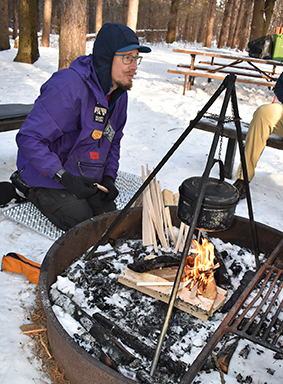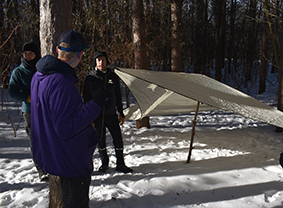Wayne Boerner has a little secret he’d like to share with anyone who enjoys camping but likes to get away from all the other people that one sometimes finds at popular campgrounds. Try it in winter.
“Whoa!” you might say. “Camping in winter in the cold and the snow? I’ll freeze my butt off!”
Not if you take time to learn how to do it, says Boerner, an avid winter camper and manager at William O’Brien State Park. And the rewards are many, from accomplishing something that might seem beyond reach, to experiencing nature in a new and different way. On top of all that, there are no mosquitoes, ticks, or poison ivy!
“I love winter,” says Boerner, “The solitude, the serene settings, the views, the animals – it’s a totally different perspective. It slows life down a little. And places that are heavily used in summer are quiet in winter.”
So what do you need to do and know to enjoy winter camping? The most important thing is to plan for how you’re going to stay warm. That means dressing in layers, says J.R. Hunte, an outdoor skills instructor who teaches classes in winter camping at the Bloomington REI. Start with a tight-fitting base layer made of something like merino wool or a synthetic fiber, then a heavier layer such as fleece or an insulating jacket, and over that a waterproof shell to keep you dry. Long johns and water-resistant pants will keep your bottom half warm. Cotton should be avoided because it holds onto moisture and sweat, and when your clothes get damp, you get cold. Make sure you have good insulated boots and a couple layers of socks to keep your feet warm, as well as good mittens or gloves.
State parks are a good place to get started, with 25 offering some winter camping (including William O’Brien and Afton state parks in the metro region). If there’s no snow in the forecast, you can probably get by with a regular three-season tent, because a tent is more about keeping you dry than keeping you warm. In snowy conditions, a winter tent is needed to bear the weight of the snow. Boerner sometimes just digs out a rectangular area in the snow big enough for a sleeping bag, spreading one end of a tarp on the bottom under his sleeping pads and bags, then pulling the other end of the tarp over the hole after he crawls in for a cozy sleeping chamber.
In summer camping, a good sleeping pad provides cushion against the hard ground; in winter, pads are necessary to prevent one from losing too much heat to the snow under your sleeping bag. Hunte recommends doubling up pads for more insulation. A good sleeping bag rated for cold weather also is important. Down bags are lightweight and provide excellent insulation, but they can be costly and if they get wet lose their insulation value. A synthetic bag with a liner can work fine. Some people put one bag inside another for extra insulating power. Hunte says it’s a good idea to build a big fire and get warmed up before crawling into your bag at night. He also recommends eating a snack such as a granola bar before retiring and taking a couple plastic water bottles filled with hot water into your bag with you.
Boerner sees an average of about 500 campers each winter at O’Brien, just north of Stillwater. About 70 percent of those stay in a trailer or RV or some type of hard shelter, while the other 30 percent stay in tents, sleep outside, or build a quinzhee by piling up snow and digging out a small cave to sleep in.
Both Boerner and Hunte recommend easing into winter camping. Try an overnight outside in your backyard to see how your equipment works. Reserve a camper cabin or a yurt at one of the Minnesota state parks that offers them.
Want To Learn More?
REI offers a winter camping class at their Bloomington store: Feb. 11 or March 6, as well as a half-day outdoor winter camping class on Feb. 2. Visit www.rei.com/stores/bloomington for info.
Tettegouche State Park on the North Shore offers a full-day introduction to winter camping on Feb. 1. Participants will build a traditional quinzhee (an insulated snow cave) and have an opportunity to sleep in it overnight if they want to. Contact DNR park naturalist Kurt Mead at 218-353-8809 or by email at kurt.mead@state.mn.us.
Visit www.mndnr.gov and type “winter activities” in the search bar for other fun things to do outdoors in winter.
























